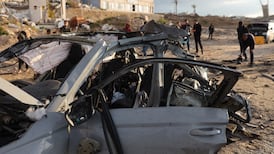Syrian families gathered around the tall Christmas tree in Azizeh Square in government-held west Aleppo on Friday, while shivering civilians swathed in blankets awaited evacuation by bus from besieged eastern districts abandoned by insurgents.
The government of Bashar al-Assad re-took full control of Aleppo, Syria’s second-largest city, this week, after the last rebel fighters were evacuated from those eastern districts.
Christians were among those celebrating in the west of the city, which has a population of 1.2 million. Christians in the east fled long ago.
The 35,000 residents evacuated over the past week face a chilly welcome and uncertain future in the opposition-controlled countryside north of the city and neighbouring Idlib province, where the UN estimates that 700,000 people displaced by the nearly six-year war have taken shelter.
During the latest fighting, more than 60,000 people from the east have taken refuge in the western and Kurdish districts, swelling the 25,000 internally displaced from the southern quarters that were engulfed in hostilities for months.
While the UN has estimated the population of eastern Aleppo at 250,000-275,000, the number of evacuees over the past three weeks shows that the figure is far lower. An official source recently told The Irish Times that the population was about 90,000, but even this could be an over-estimation.
Divided
Aleppo was a divided city before unrest erupted in March 2011. The division was largely socio-economic, with the west being more prosperous than the east. The disparities between the western and eastern sectors increased after the Syrian government adopted a free-market economic model in 2005.
The affluent and middle classes in the west benefited from increased trade, lower tariffs, subsidy reductions and increased tourism, but low-income groups in the east and the countryside suffered, particularly after workers lost jobs when manufacturing firms closed due to an influx of cheap Turkish goods.
Farmers who had lost land and income during the 2006-10 drought were in the vanguard of the armed revolt against the Syrian regime.
In a 2014 report on Aleppo, prepared by the American strategic consulting firm Caerus Associates, an unidentified rebel fighter said: “We liberated the rural parts of this province. We waited and waited for Aleppo to rise, and it didn’t. We couldn’t rely on them to do it for themselves, so we had to bring the revolution to them.”
While the west was determined to retain the pro-government status quo, the disadvantaged east provided fertile ground for the rebels. A former senior official said the governor of Aleppo appealed repeatedly to Damascus for military aid, but this was not forthcoming.
Rebel factions
The eastern quarters of Syria's largest city fell to an array of rebel factions. They established local councils incapable of providing effective governance, protection or humanitarian assistance for the increasingly impoverished population. Competing factions were eventually absorbed or dominated by Jabhat Fateh al-Sham, an al-Qaeda affiliate formerly known as the Al-Nusra Front, and its partner, Ahrar al-Sham, which were determined to hold on to the east whatever the price.
The Syrian government continued to administer the west, paying the salaries of civil servants, keeping banks open, maintaining hospitals, schools and universities, and providing goods and services. Life was relatively normal there, with restaurants, shops, churches and mosques continuing to function.
Nevertheless, merchants, professionals and residents with means relocated to Damascus or Latakia on the coast. Many people who stayed on could not afford to go elsewhere.
Along with the displaced, they will need international humanitarian aid to survive. The government’s victory has been won at great cost to western Aleppo as well.













